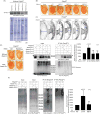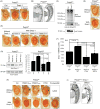The deubiquitinase ataxin-3 requires Rad23 and DnaJ-1 for its neuroprotective role in Drosophila melanogaster
- PMID: 26007638
- PMCID: PMC4710962
- DOI: 10.1016/j.nbd.2015.05.010
The deubiquitinase ataxin-3 requires Rad23 and DnaJ-1 for its neuroprotective role in Drosophila melanogaster
Abstract
Ataxin-3 is a deubiquitinase and polyglutamine (polyQ) disease protein with a protective role in Drosophila melanogaster models of neurodegeneration. In the fruit fly, wild-type ataxin-3 suppresses toxicity from several polyQ disease proteins, including a pathogenic version of itself that causes spinocerebellar ataxia type 3 and pathogenic huntingtin, which causes Huntington's disease. The molecular partners of ataxin-3 in this protective function are unclear. Here, we report that ataxin-3 requires its direct interaction with the ubiquitin-binding and proteasome-associated protein, Rad23 (known as hHR23A/B in mammals) in order to suppress toxicity from polyQ species in Drosophila. According to additional studies, ataxin-3 does not rely on autophagy or the proteasome to suppress polyQ-dependent toxicity in fly eyes. Instead this deubiquitinase, through its interaction with Rad23, leads to increased protein levels of the co-chaperone DnaJ-1 and depends on it to protect against degeneration. Through DnaJ-1, our data connect ataxin-3 and Rad23 to protective processes involved with protein folding rather than increased turnover of toxic polyQ species.
Keywords: Ataxin-3; Chaperone; Deubiquitinase; Drosophila; Machado–Joseph disease; Polyglutamine; Ubiquitin.
Copyright © 2015. Published by Elsevier Inc.
Conflict of interest statement
The authors declare that they have no competing interests.
Figures





Similar articles
-
Interaction of the polyglutamine protein ataxin-3 with Rad23 regulates toxicity in Drosophila models of Spinocerebellar Ataxia Type 3.Hum Mol Genet. 2017 Apr 15;26(8):1419-1431. doi: 10.1093/hmg/ddx039. Hum Mol Genet. 2017. PMID: 28158474 Free PMC article.
-
Toxicity and aggregation of the polyglutamine disease protein, ataxin-3 is regulated by its binding to VCP/p97 in Drosophila melanogaster.Neurobiol Dis. 2018 Aug;116:78-92. doi: 10.1016/j.nbd.2018.04.013. Epub 2018 Apr 26. Neurobiol Dis. 2018. PMID: 29704548 Free PMC article.
-
Ubiquitin-binding site 2 of ataxin-3 prevents its proteasomal degradation by interacting with Rad23.Nat Commun. 2014 Aug 21;5:4638. doi: 10.1038/ncomms5638. Nat Commun. 2014. PMID: 25144244 Free PMC article.
-
Toward therapeutic targets for SCA3: Insight into the role of Machado-Joseph disease protein ataxin-3 in misfolded proteins clearance.Prog Neurobiol. 2015 Sep;132:34-58. doi: 10.1016/j.pneurobio.2015.06.004. Epub 2015 Jun 27. Prog Neurobiol. 2015. PMID: 26123252 Review.
-
The deubiquitinase function of ataxin-3 and its role in the pathogenesis of Machado-Joseph disease and other diseases.Biochem J. 2024 Mar 20;481(6):461-480. doi: 10.1042/BCJ20240017. Biochem J. 2024. PMID: 38497605 Free PMC article. Review.
Cited by
-
The ubiquitin thioesterase YOD1 ameliorates mutant Huntingtin induced pathology in Drosophila.Sci Rep. 2023 Dec 11;13(1):21951. doi: 10.1038/s41598-023-49241-8. Sci Rep. 2023. PMID: 38081944 Free PMC article.
-
Ubiquitin-binding site 1 of pathogenic ataxin-3 regulates its toxicity in Drosophila models of Spinocerebellar Ataxia Type 3.Front Neurosci. 2023 Jan 17;16:1112688. doi: 10.3389/fnins.2022.1112688. eCollection 2022. Front Neurosci. 2023. PMID: 36733922 Free PMC article.
-
Non-Proteasomal UbL-UbA Family of Proteins in Neurodegeneration.Int J Mol Sci. 2019 Apr 17;20(8):1893. doi: 10.3390/ijms20081893. Int J Mol Sci. 2019. PMID: 30999567 Free PMC article. Review.
-
Targeting the VCP-binding motif of ataxin-3 improves phenotypes in Drosophila models of Spinocerebellar Ataxia Type 3.Neurobiol Dis. 2021 Dec;160:105516. doi: 10.1016/j.nbd.2021.105516. Epub 2021 Sep 24. Neurobiol Dis. 2021. PMID: 34563642 Free PMC article.
-
A Novel Insecticidal Molecule Extracted from Alpinia galanga with Potential to Control the Pest Insect Spodoptera frugiperda.Insects. 2020 Oct 11;11(10):686. doi: 10.3390/insects11100686. Insects. 2020. PMID: 33050622 Free PMC article.
References
-
- Becker J, et al. Hydrogen peroxide activates immediate binding of a Drosophila factor to DNA heat-shock regulatory element in vivo and in vitro. Eur J Biochem. 1990;189:553–558. - PubMed
-
- Brand AH, Perrimon N. Targeted gene expression as a means of altering cell fates and generating dominant phenotypes. Development. 1993;118:401–415. - PubMed
Publication types
MeSH terms
Substances
Grants and funding
LinkOut - more resources
Full Text Sources
Other Literature Sources
Medical
Molecular Biology Databases

